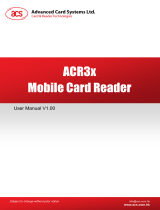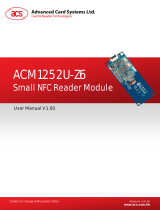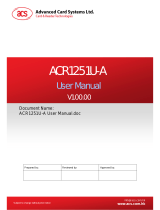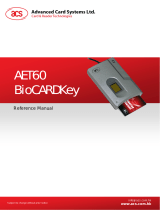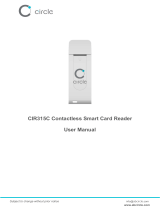Page is loading ...

Reference Manual V1.03
ACM1281U-C7
USB Contactless Reader
Module with SAM Slot

Page 2 of 44
www.acs.com
.hk
Revision History
Release Date
Revision Description
Version Number
2015-04-22
● Initial Release
1.00
2017-05-31
● Updated Section 2.0 Features
1.01
2020-06-01
● Updated Section 2.0 Features
● Updated Section 5.0 Host Programming
(PC-Linked) API
1.02
2020-06-16
● Updated Section 5.2.5 Set Default LED and
Buzzer Behavior
● Updated Section 5.2.6 Read Default LED
and Buzzer Behavior
1.03

Page 3 of 44
www.acs.com
.hk
Table of Contents
1.0. Introduction ............................................................................................................... 5
2.0. Features ..................................................................................................................... 6
3.0. ACM1281U-C7 Architecture ..................................................................................... 7
3.1. Reader Block Diagram ........................................................................................................... 7
3.2. Communication between PC/SC driver PICC and SAM ....................................................... 7
4.0. Hardware Design ....................................................................................................... 8
4.1. USB ........................................................................................................................................ 8
4.1.1. Communication Parameters ......................................................................................... 8
4.1.2. Endpoints ...................................................................................................................... 8
4.2. Contactless Smart Card Interface ......................................................................................... 8
4.2.1. Carrier Frequency ......................................................................................................... 8
4.2.2. Card Polling ................................................................................................................... 8
4.3. User Interface ........................................................................................................................ 9
4.3.1. Buzzer ........................................................................................................................... 9
4.3.2. LED ............................................................................................................................... 9
5.0. Host Programming (PC-Linked) API ...................................................................... 10
5.1. Contactless Smart Card Protocol ........................................................................................ 10
5.1.1. ATR Generation .......................................................................................................... 10
5.1.2. Pseudo APDUs for Contactless Interface ................................................................... 13
5.1.3. PICC Commands (T=CL Emulation) for MIFARE 1K/4K Memory Cards ................... 14
5.1.4. Access PC/SC-compliant tags (ISO 14443-4) ............................................................ 24
5.1.5. Accessing MIFARE DESFire tags (ISO 14443-4) ....................................................... 25
5.2. Peripherals Control .............................................................................................................. 27
5.2.1. Get Firmware Version ................................................................................................. 27
5.2.2. LED Control ................................................................................................................. 28
5.2.3. LED Status .................................................................................................................. 29
5.2.4. Buzzer Control ............................................................................................................ 30
5.2.5. Set Default LED and Buzzer Behaviors ...................................................................... 31
5.2.6. Read Default LED and Buzzer Behaviors ................................................................... 32
5.2.7. Set Automatic PICC Polling ........................................................................................ 33
5.2.8. Read Automatic PICC Polling ..................................................................................... 35
5.2.9. Manual PICC Polling ................................................................................................... 36
5.2.10. Set PICC Operating Parameter .................................................................................. 37
5.2.11. Read PICC Operating Parameter ............................................................................... 38
Appendix A. Basic program flow for contactless applications.................................... 39
Appendix B. Extended APDU Example .......................................................................... 40
Appendix C. Escape Command Example ...................................................................... 42
Appendix D. ACR128 Compatibility ................................................................................ 43

Page 4 of 44
www.acs.com
.hk
List of Figures
Figure 1 : ACM1281U-C7 Reader Block Diagram ................................................................................. 7
Figure 2 : ACM1281U-C7 Architecture .................................................................................................. 7
List of Tables
Table 1 : USB Interface Wiring ............................................................................................................... 8
Table 2 : Buzzer Event ........................................................................................................................... 9
Table 3 : LED Indicator ........................................................................................................................... 9
Table 4 : ISO 14443 Part 3 ATR Format .............................................................................................. 10
Table 5 : ISO 14443 Part 4 ATR Format .............................................................................................. 11
Table 6 : MIFARE 1K Memory Map ...................................................................................................... 17
Table 7 : MIFARE 4K Memory Map ...................................................................................................... 17
Table 8 : MIFARE Ultralight Memory Map ............................................................................................ 18

Page 5 of 44
www.acs.com
.hk
1.0. Introduction
The ACM1281U-C7 USB Contactless Reader Module with SAM Slot,
running on the 13.56 MHz frequency, was designed for fast and easy
integration to embedded systems. It makes use of the USB CCID
class driver and accepts card commands from the computer
application.
The ACM1281U-C7 has an integrated (on-board) antenna and comes
with an optional USB cable. It also has additional features like
firmware upgradeability and extended APDU support.
It supports ISO 14443 Parts 1-4 Type A and B cards, and MIFARE Classic® series. It also has a built-
in ISO 7816 Compliant Class A SAM (Secure Access Module) slot, which can be used together with a
SAM card for enhanced security. It has a maximum of 848 Kbps high-speed communication ability
with contactless cards, making it suitable for highly demanding smart card applications like vending
machine payment systems, kiosks, gaming machines, and other integrated systems.
This Reference Manual will discuss in detail how the PC/SC APDU commands are implemented for
the contactless interface, SAM card support and device peripherals of ACM1281U-C7.

Page 6 of 44
www.acs.com
.hk
2.0. Features
• USB Full Speed Interface
• Smart Card Reader:
o Contactless Interface:
▪ Read/Write speed of up to 848 Kbps
▪ Built-in antenna for contactless tag access, with card reading distance of up to 50 mm
(depending on tag type)
▪ Supports ISO 14443 Part 4 Type A and B cards and MIFARE Classic series
▪ Built-in anti-collision feature (only one tag is accessed at any time)
▪ Supports extended APDU (Max. 64 KB)
o SAM Interface:
▪ One SAM Slot
▪ ISO 7816-compliant Class A SAM cards
• Application Programming Interface:
o Supports PC/SC
o Supports CT-API (through wrapper on top of PC/SC)
• Built-in Peripherals:
o Two user-controllable LEDs
o User-controllable buzzer
• USB Firmware Upgradeability
• Supports Android™ 3.1 and later
1
• Compliant with the following standards:
o ISO 14443
o ISO 7816
o PC/SC
o CCID
o CE
o FCC
o RoHS
o REACH
o Microsoft® WHQL
1
Uses an ACS-defined Android Library

Page 7 of 44
www.acs.com
.hk
3.0. ACM1281U-C7 Architecture
3.1. Reader Block Diagram
Figure 1: ACM1281U-C7 Reader Block Diagram
3.2. Communication between PC/SC driver PICC and SAM
The protocol used between ACM1281U-C7 and the PC is CCID. All communications between PICC
and SAM are PC/SC-compliant.
Figure 2: ACM1281U-C7 Architecture

Page 8 of 44
www.acs.com
.hk
4.0. Hardware Design
4.1. USB
The ACM1281U-C7 connects to a computer through USB following the USB standard.
4.1.1. Communication Parameters
The ACM1281U-C7 connects to a computer through USB as specified in the USB Specification 2.0.
The ACM1281U-C7 works in full-speed mode, i.e. 12 Mbps.
Pin
Signal
Function
1
V
BUS
+5 V power supply for the reader
2
D-
Differential signal transmits data between ACM1281U-C7 and PC
3
D+
Differential signal transmits data between ACM1281U-C7 and PC
4
GND
Reference voltage level for power supply
Table 1: USB Interface Wiring
Note
:
The device driver should be installed for ACM1281U-C7 to function properly through USB
interface.
4.1.2. Endpoints
The ACM1281U-C7 uses the following endpoints to communicate with the host computer:
Control Endpoint – For setup and control purposes.
Bulk-OUT – For commands to be sent from host to ACM1281U-C7 (data packet size is 64 bytes).
Bulk-IN – For response to be sent from ACM1281U-C7 to host (data packet size is 64 bytes).
Interrupt-IN – For card status message to be sent from ACM1281U-C7 to host (data packet size
is 8 bytes).
4.2. Contactless Smart Card Interface
The interface between the ACM1281U-C7 and the contactless card follows the specifications of ISO
14443 with certain restrictions or enhancements to increase the practical functionality of the
ACM1281U-C7.
4.2.1. Carrier Frequency
The carrier frequency for ACM1281U-C7 is 13.56 MHz.
4.2.2. Card Polling
The ACM1281U-C7 automatically polls the contactless cards that are within the field. ISO 14443-4
Type A, ISO 14443-4 Type B and MIFARE cards are supported.

Page 9 of 44
www.acs.com
.hk
4.3. User Interface
4.3.1. Buzzer
A monotone buzzer is used to indicate the “Card Insertion” and “Card Removal” events.
Events
Buzzer
1. The reader is powered up and successfully initialized.
Beep
2. Card Insertion Event (PICC)
Beep
3. Card Removal Event (PICC)
Beep
Table 2: Buzzer Event
4.3.2. LED
The LEDs are used to indicate the state of the contact and contactless interfaces. The Red LED is
used to indicate PICC status and the Green LED is used to indicate ICC status.
Reader States
Red LED
PICC Indicator
Green LED
ICC Indicator
1. No PICC Found or PICC present but
not activated.
A single pulse per ~ 5 seconds
N/A
2. PICC is present and activated.
ON
N/A
3. PICC is operating.
Blinking
N/A
Table 3: LED Indicator

Page 10 of 44
www.acs.com
.hk
5.0. Host Programming (PC-Linked) API
5.1. Contactless Smart Card Protocol
5.1.1. ATR Generation
If the reader detects a PICC, an ATR will be sent to the PC/SC driver to identify the PICC.
5.1.1.1. ATR Format for ISO 14443 Part 3 PICCs
Byte
Value (Hex)
Designation
Description
0
3Bh
Initial
Header
-
1
8Nh
T0
Higher nibble 8 means: no TA1, TB1, TC1
only TD1 is following.
Lower nibble N is the number of historical
bytes (HistByte 0 to HistByte N-1)
2
80h
TD1
Higher nibble 8 means: no TA2, TB2, TC2
only TD2 is following.
Lower nibble 0 means T = 0
3
01h
TD2
Higher nibble 0 means no TA3, TB3, TC3,
TD3 following.
Lower nibble 1 means T = 1
4 to
3+N
80h
T1
Category indicator byte, 80 means A status
indicator may be present in an optional
COMPACT-TLV data object
4Fh
Tk
Application identifier Presence Indicator
0Ch
Length
RID
Registered Application Provider Identifier
(RID) # A0 00 00 03 06h
SS
Byte for standard
C0h.. C1h
Bytes for card name
00 00 00 00h
RFU
RFU # 00 00 00 00h
4+N
UU
TCK
Exclusive-oring of all the bytes T0 to Tk
Table 4: ISO 14443 Part 3 ATR Format
Example:
ATR for MIFARE 1K = {3B 8F 80 01 80 4F 0C A0 00 00 03 06 03 00 01 00 00 00 00 6Ah}
ATR
Initial
Header
T0
TD1
TD2
T1
Tk
Length
RID
Standard
Card
Name
RFU
TCK
3Bh
8Fh
80h
01h
80h
4Fh
0Ch
A0
00
00
03
06h
03h
00h
01h
00
00
00
00h
6Ah

Page 11 of 44
www.acs.com
.hk
Where:
Length (YY) = 0Ch
RID = A0 00 00 03 06h (PC/SC Workgroup)
Standard (SS) = 03h (ISO 14443A, Part 3)
Card Name (C0 ... C1) = [00 01h] (MIFARE 1K)
[00 02h] (MIFARE 4K)
[00 03h] (MIFARE Ultralight)
[00 26h] (MIFARE Mini)
[00 36h] (MIFARE PLUS SL1_2K)
[00 37h] (MIFARE PLUS SL1_4K)
[00 38h] (MIFARE PLUS SL2_2K)
[00 39h] (MIFARE PLUS SL2_4K)
[00 3Ah] (MIFARE Ultralight C)
[FF 28h] JCOP 30
FF SAK undefined tags
5.1.1.2. ATR Format for ISO 14443 Part 4 PICCs
Byte
Value (Hex)
Designation
Description
0
3Bh
Initial Header
-
1
8Nh
T0
Higher nibble 8 means: no TA1, TB1, TC1 only TD1 is
following.
Lower nibble N is the number of historical bytes (HistByte 0
to HistByte N-1)
2
80h
TD1
Higher nibble 8 means: no TA2, TB2, TC2 only TD2 is
following.
Lower nibble 0 means T = 0
3
01h
TD2
Higher nibble 0 means no TA3, TB3, TC3, TD3 following.
Lower nibble 1 means T = 1
4 to
3 + N
XX
T1
Historical Bytes:
ISO 14443A:
The historical bytes from ATS response. Refer to the ISO
14443-4 specification.
ISO 14443B:
Byte1-4
Byte5-7
Byte8
Application
Data from
ATQB
Protocol Info
Byte from
ATQB
Higher nibble=MBLI
from ATTRIB
command Lower nibble
(RFU)=0
XX
XX
XX
Tk
4+N
UU
TCK
Exclusive-oring of all the bytes T0 to Tk
Table 5: ISO 14443 Part 4 ATR Format

Page 12 of 44
www.acs.com
.hk
Example 1: Consider the ATR from MIFARE® DESFire® as follows:
MIFARE DESFire (ATR) = 3B 81 80 01 80 80h (6 bytes of ATR)
Note: Use the APDU “FF CA 01 00 00h” to distinguish the ISO 14443A-4 and ISO 14443B-4 PICCs
and retrieve the full ATS if available. The ATS is returned for ISO 14443A-3 or ISO 14443B-3/4
PICCs.
APDU Command = FF CA 01 00 00h
APDU Response = 06 75 77 81 02 90 00h
ATS = {06 75 77 81 02 80h}
Example 2: Consider the ATR from EZ-Link as follows:
EZ-Link (ATR) = 3B 88 80 01 1C 2D 94 11 F7 71 85 00 BEh
Application Data of ATQB = 1C 2D 94 11h
Protocol Information of ATQB = F7 71 85h
MBLI of ATTRIB = 00h

Page 13 of 44
www.acs.com
.hk
5.1.2. Pseudo APDUs for Contactless Interface
5.1.2.1. Get Data
This command is used to return the serial number or ATS of the connected PICC.
Command
Command
Class
INS
P1
P2
Le
Get Data
FFh
CAh
00h
01h
00h
00h
(Full Length)
Get UID Response if P1 = 00h
Response
UID
…
…
UID
SW1
SW2
Result
LSB
MSB
Get ATS Response if P1 = 01h (for ISO 14443-A cards only)
Response
Data Out
Result
ATS
SW1
SW2
Response Code
Results
SW1 SW2
Meaning
Success
90 00h
The operation was completed successfully.
Warning
62 82h
End of UID/ATS reached before Le bytes (Le is greater than
UID Length).
Error
6C XXh
Wrong length (wrong number Le: ‘XX’ encodes the exact
number) if Le is less than the available UID length.
Error
63 00h
The operation failed.
Error
6A 81h
Function not supported.
Example 1: To get the serial number of the connected PICC:
UINT8 GET_UID[5] = {FF CA 00 00 00h};
Example 2: To get the ATS of the connected ISO 14443-A PICC:
UINT8 GET_ATS[5] = {FF CA 01 00 00h};

Page 14 of 44
www.acs.com
.hk
5.1.3. PICC Commands (T=CL Emulation) for MIFARE 1K/4K Memory Cards
5.1.3.1. Load Authentication Keys
This command is used to load the authentication keys into the reader. The authentication keys are
used to authenticate the specified sector of the MIFARE 1K/4K Memory Card. Two kinds of
authentication key locations are provided, volatile and non-volatile key locations.
Command
Command
Class
INS
P1
P2
Le
Data In
Load Authentication Keys
FFh
82h
Key
Structure
Key
Number
06h
Key
Where:
Key Structure (1 Byte)
00h = Key is loaded into the reader’s volatile memory
20h = Key is loaded into the reader’s non-volatile memory
Other = Reserved
Key Number (1 Byte)
00h – 1Fh = Non-volatile memory for storing keys. The keys are
permanently stored in the reader and will not be erased even if the
reader is disconnected from the PC. It can store up to 32 keys inside
the reader non-volatile memory.
20h (Session Key) = Volatile memory for temporarily storing keys.
The keys will be erased when the reader is disconnected from the
PC. Only one volatile memory is provided. The volatile key can be
used as a session key for different sessions. Default value = FF FF
FF FF FF FFh.
Key (6 Bytes)
The key value loaded into the reader.
E.g. {FF FF FF FF FF FFh}
Response
Response
Data Out
Result
SW1
SW2
Where:
SW1 SW2 = 90 00h means the operation was completed successfully.
= 63 00h means the operation failed.
Example1:
Load a key { FF FF FF FF FF FFh } into the non-volatile memory location 05h.
APDU = {FF 82 20 05 06 FF FF FF FF FF FFh}
Load a key { FF FF FF FF FF FFh } into the volatile memory location 20h.
APDU = {FF 82 00 20 06 FF FF FF FF FF FFh}

Page 15 of 44
www.acs.com
.hk
Notes:
1. The application should know all the keys being used. It is recommended to store all the
required keys to the non-volatile memory for security reasons. The contents of both volatile
and non-volatile memories are not readable by any application.
2. The content of the volatile memory “Session Key 20h” will remain valid until the reader is
reset or powered-off. The session key is useful for storing any key value that is changing from
time to time. The session key is stored in the “Internal RAM”, while the non-volatile keys are
stored in “EEPROM” that is relatively slower than the “Internal RAM”.
3. It is not recommended to use the “non-volatile key locations 00-1Fh” to store any “temporary
key” that will be changed frequently. The “non-volatile keys” are supposed to be used for
storing any “key value” that will not change frequently. If the ”key value” is supposed to be
changed from time to time, store the “key value” to the “volatile key location 20h” instead.

Page 16 of 44
www.acs.com
.hk
5.1.3.2. Authentication for MIFARE 1K/4K
This command is used to authenticate the MIFARE 1K/4K card (PICC) using the keys stored in the
reader. Two types of authentication keys are used: Type_A and Type_B.
Command
Command
Class
INS
P1
P2
P3
Data In
Authentication
6 Bytes (Obsolete)
FFh
88h
00h
Block Number
Key Type
Key Number
Command
Class
INS
P1
P2
Lc
Data In
Authentication
10 Bytes
FFh
86h
00h
00h
05h
Authenticate Data Bytes
Where:
Authenticate Data Bytes (5 Bytes)
Byte 1
Byte 2
Byte 3
Byte 4
Byte 5
Version
01h
00h
Block Number
Key Type
Key Number
Where:
Block Number (1 Byte)
The memory block to be authenticated.
Note: For MIFARE 1K card, it has a total of 16 sectors and each sector consists of 4
consecutive blocks. For example, Sector 00h consists of Blocks {00h, 01h, 02h and 03h};
Sector 01h consists of Blocks {04h, 05h, 06h and 07h}; the last sector 0Fh consists of Blocks
{3Ch, 3Dh, 3Eh and 3Fh}.
Once the authentication is done successfully, there is no need to do the authentication again
provided that the blocks to be accessed belong to the same sector. Please refer to the
MIFARE 1K/4K specification for more details.
Key Type (1 Byte)
60h = Key is used as Key A key for authentication.
61h = Key is used as Key B key for authentication.
Key Number (1 Byte)
00h – 1Fh = Non-volatile memory for storing keys. The keys are
permanently stored in the reader and will not be erased even if the
reader is disconnected from the PC. It can store up to 32 keys inside
the reader non-volatile memory.
20h (Session Key) = Volatile memory for temporarily storing keys.
The keys will be erased when the reader is disconnected from the
PC. Only 1 volatile memory is provided. The volatile key can be used
as a session key for different sessions. Default value = FF FF FF FF
FF FFh.

Page 17 of 44
www.acs.com
.hk
Response
Response
Data Out
Result
SW1
SW2
Where:
SW1 SW2 = 90 00h means the operation was completed successfully.
= 63 00h means the operation failed.
Sectors
(Total of 16 sectors. Each
sector consists of 4
consecutive blocks)
Data Blocks
(3 blocks, 16 bytes per
block)
Trailer Block
(1 block, 16 bytes)
Sector 0
00h ~ 02h
03h
Sector 1
04h ~ 06h
07h
..
..
Sector 14
38h ~ 0Ah
3Bh
Sector 15
3Ch ~ 3Eh
3Fh
Table 6: MIFARE 1K Memory Map
Sectors
(Total of 32 sectors. Each
sector consists of 4
consecutive blocks)
Data Blocks
(3 blocks, 16 bytes per
block)
Trailer Block
(1 block, 16 bytes
Sector 0
00h ~ 02h
03h
Sector 1
04h ~ 06h
07h
...
...
Sector 30
78h ~ 7Ah
7Bh
Sector 31
7Ch ~ 7Eh
7Fh
Sectors
(Total of 32 sectors. Each
sector consists of 4
consecutive blocks)
Data Blocks
(3 blocks, 16 bytes per
block)
Trailer Block
(1 block, 16 bytes
Sector 32
80h ~ 8Eh
8Fh
Sector 33
90h ~ 9Eh
9Fh
...
...
Sector 38
E0h ~ EEh
EFh
Sector 39
F0h ~ FEh
FFh
Table 7: MIFARE 4K Memory Map
2 KB
2 KB
1 KB

Page 18 of 44
www.acs.com
.hk
Example 1:
To authenticate Block 04h with the following characteristics: Key A, key number 00h, from PC/SC
V2.01 (Obsolete).
APDU = { FF 88 00 04 60 00h }
Example 2:
Similar to the previous example, to authenticate Block 04h with the following characteristics: Key A,
key number 00h, from PC/SC V2.07.
APDU = { FF 86 00 00 05 01 00 04 60 00h }
Note: MIFARE® Ultralight does not need authentication since it provides free access to the user data
area.
Byte Number
0
1
2
3
Page
Serial Number
SN0
SN1
SN2
BCC0
0
Serial Number
SN3
SN4
SN5
SN6
1
Internal/Lock
BCC1
Internal
Lock0
Lock1
2
OTP
OPT0
OPT1
OTP2
OTP3
3
Data read/write
Data0
Data1
Data2
Data3
4
Data read/write
Data4
Data5
Data6
Data7
5
Data read/write
Data8
Data9
Data10
Data11
6
Data read/write
Data12
Data13
Data14
Data15
7
Data read/write
Data16
Data17
Data18
Data19
8
Data read/write
Data20
Data21
Data22
Data23
9
Data read/write
Data24
Data25
Data26
Data27
10
Data read/write
Data28
Data29
Data30
Data31
11
Data read/write
Data32
Data33
Data34
Data35
12
Data read/write
Data36
Data37
Data38
Data39
13
Data read/write
Data40
Data41
Data42
Data43
14
Data read/write
Data44
Data45
Data46
Data47
15
Table 8: MIFARE Ultralight Memory Map
512 bits
or
64 bytes

Page 19 of 44
www.acs.com
.hk
5.1.3.3. Read Binary Blocks
This command is used to retrieve multiple data blocks from the PICC. The data block/trailer must be
authenticated first before executing this command.
Command
Command
Class
INS
P1
P2
Le
Read Binary Blocks
FFh
B0h
00h
Block Number
Number of Bytes to Read
Where:
Block Number (1 Byte)
Starting Block
Number of Bytes to Read The length of the bytes to be read can be a multiple of 16 bytes
for MIFARE 1K/4K or a multiple of 4 bytes for MIFARE Ultralight (1
Byte).
Maximum of 16 bytes for MIFARE Ultralight.
Maximum of 48 bytes for MIFARE 1K (Multiple Blocks Mode; 3
consecutive blocks).
Maximum of 240 bytes for MIFARE 4K (Multiple Blocks Mode; 15
consecutive blocks).
Example 1: 10h (16 bytes). Starting block only. (Single Block Mode)
Example 2: 40h (64 bytes). From starting block to starting block +3. (Multiple Blocks Mode)
Note: For security considerations, the Multiple Block Mode is used for accessing data blocks only.
The Trailer Block is not supposed to be accessed in Multiple Blocks Mode. Please use Single Block
Mode to access the Trailer Block.
Response
Response
Data Out
Result
Data (Multiple of 4 or 16 bytes)
SW1
SW2
Where:
SW1 SW2 = 90 00h means the operation was completed successfully.
= 63 00h means the operation failed.
Example 1: Read 16 bytes from the binary block 04h (MIFARE 1K or 4K).
APDU = { FF B0 00 04 10h }
Example 2: Read 240 bytes starting from the binary block 80h (MIFARE 4K). Block 80h to Block 8Eh
(15 blocks).
APDU = { FF B0 00 80 F0 }

Page 20 of 44
www.acs.com
.hk
5.1.3.4. Update Binary Blocks
This command is used to write multiple data blocks into the PICC. The data block/trailer block must be
authenticated first before executing this command.
Command
Command
Class
INS
P1
P2
Le
Data In
Update
Binary Blocks
FFh
D6h
00h
Block Number
Number of Bytes to
Update
Block Data (Multiple of
16 Bytes)
Where:
Block Number (1 Byte)
Starting Block
Block Data Multiple of 16 + 2 Bytes, or 6 Bytes. Data to be written into
the binary blocks.
Number of Bytes to Read The length of the bytes to be read can be a multiple of 16
bytes for MIFARE 1K/4K or a multiple of 4 bytes for MIFARE
Ultralight (1 Byte).
Maximum of 16 Bytes for MIFARE Ultralight.
Maximum of 48 Bytes for MIFARE 1K (Multiple Blocks Mode;
3 consecutive blocks).
Maximum of 240 Bytes for MIFARE 4K (Multiple Blocks
Mode; 15 consecutive blocks).
Example 1: 10h (16 Bytes). Starting block only. (Single Block Mode)
Example 2: 30h (48 Bytes). From starting block to starting block +2. (Multiple Blocks Mode)
Note: For security considerations, the Multiple Block Mode is used for accessing data blocks only.
The Trailer Block is not supposed to be accessed in Multiple Blocks Mode. Please use Single Block
Mode to access the Trailer Block.
Response
Response
Data Out
Result
SW1
SW2
Where:
SW1 SW2 = 90 00h means the operation was completed successfully.
= 63 00h means the operation failed.
Example 1: Update the binary block 04h of MIFARE 1K/4K with Data {00 01 .. 0Fh}
APDU = { FF D6 00 04 10 00 01 02 03 04 05 06 07 08 09 0A 0B 0C 0D 0E 0Fh
}
Example 2: Update the binary block 04h of MIFARE Ultralight with Data { 00 01 02 03h }
APDU = {FF D6 00 04 04 00 01 02 03h}
/



